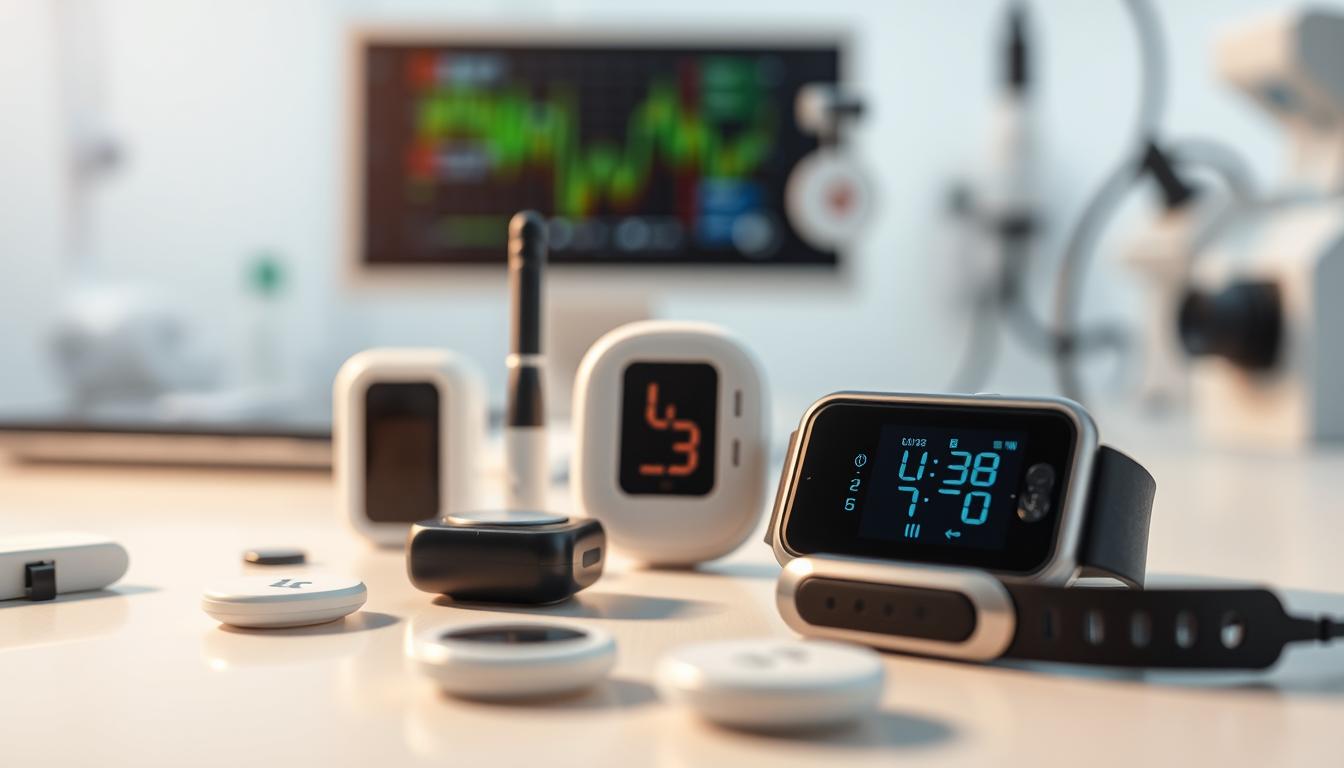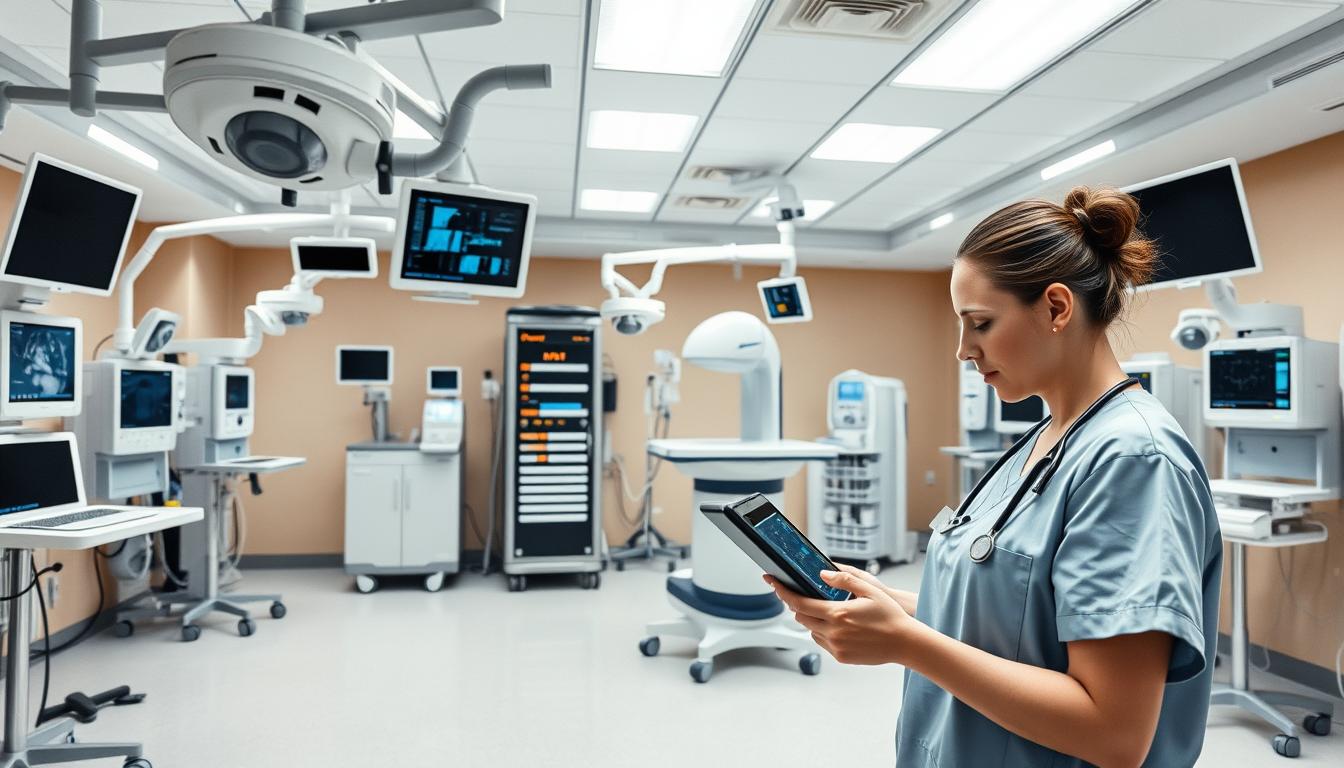A short story: At a busy U.S. hospital, a nurse once rushed between floors hunting for a vital
infusion pump. A real-time tag pinged from a laptop, and the pump was found in minutes. That small win turned a long
delay into immediate care.
This guide explains how connected sensors, devices, and platforms turn real-time clinical and operational
data into safer, higher-quality patient care. You will learn foundational concepts, reference architectures, and
high-value use cases that matter to American providers.
We describe RTLS with BLE, RFID, and Wi‑Fi, plus environmental monitoring and wearables that capture vitals. Cisco
Catalyst and Meraki access points can act as gateways, helping centralize device visibility and alerts across sites.
Why now: Aging populations, rising chronic disease, and staffing gaps push hospitals to adopt
resilient, network-friendly technologies that scale. This section sets the stage for practical steps to improve
outcomes, speed interventions, and avoid vendor lock-in.

Key Takeaways
- Connected devices and sensors make real-time monitoring actionable for providers.
- RTLS, wearables, and environmental sensors reduce delays and improve outcomes.
- Network gateways like Cisco Catalyst and Meraki simplify deployments.
- Open ecosystems and centralized management ease scaling across systems of care.
- Security, compliance, and interoperability are non-negotiable for U.S. adoption.
What Is Healthcare IoT and Why It Matters Now in the United States
Real-time device telemetry and sensor feeds turn episodic visits into continuous patient observation across care
sites.
Defining the system
Healthcare iot healthcare is a network of connected devices and sensors that stream clinical and
operational data into workflows. These signals enable continuous monitoring, automated alerts, and faster decisions
that improve patient care.
Present-day pressures
U.S. systems face aging populations, rising chronic conditions, and persistent staffing shortages. COVID-19 showed
the need to scale remote-ready technologies to manage capacity and cost.
Continuous monitoring captures vitals, behavior, and environmental context so providers intervene earlier
and cut unnecessary readmissions.

| Device Type | Data Collected | Primary Benefit |
|---|---|---|
| Clinical wearables | Heart rate, SpO2, activity | Early warning of decline |
| Environmental sensors | Temp, humidity, air quality | Compliance and infection control |
| RTLS tags & telemetry | Location, equipment status | Faster time-to-care and asset use |
Why timing matters: value-based payment and capacity limits reward technologies that boost
visibility and reduce time to treatment. Strong connectivity and device management keep data reliable and equitable
across rural and urban populations. The next section maps how sensors, networks, and analytics form a secure,
scalable architecture.
Inside an IoT Healthcare Architecture: From Sensors to Insights
A layered architecture turns raw sensor signals into clinical alerts and operational dashboards.
Perception layer
Perception layer: sensing vitals and equipment state
Wearables, biosensors, RFID tags, cameras, and GPS modules collect heart rate, blood pressure, glucose, movement,
temperature, humidity, and asset location.
These inputs help teams monitor patients and track equipment in real
time.
Network layer
Network layer: moving signals reliably
BLE handles low-power proximity tasks. Wi‑Fi delivers high throughput across campuses. RFID supports precise
tracking.
LPWAN (NB‑IoT/LoRaWAN) spans long range with low power, while 4G/5G provides mobility and resilience.

Application and analytics
Application layer and data: turning streams into workflows
Dashboards, alert rules, and API-based integration feed EHRs and service desks. Edge computing reduces latency for
critical monitoring and lowers bandwidth needs.
AI/ML on curated data enables anomaly detection and predictive
maintenance of equipment.
| Layer | Key Components | Primary Benefit |
|---|---|---|
| Perception | Wearables, biosensors, RFID, cameras | Continuous vitals and asset telemetry |
| Network | BLE, Wi‑Fi, LPWAN, 4G/5G, RFID | Reliable signal transport across facilities |
| Application & Data | Dashboards, edge nodes, AI/ML, APIs | Actionable alerts and integrated workflows |
Governance and integration matter. Role-based access, encryption in transit and at rest, and audit
logs protect sensitive data.
Using Cisco Catalyst and Meraki access points as gateways can reduce additional
hardware and speed deployment across existing infrastructure.
Core Technologies Powering Smart Hospitals and Remote Care
Modern hospitals depend on a set of complementary technologies to track equipment, monitor conditions, and
keep patients safe. These building blocks turn raw signals into timely actions that reduce delays and cut
costs.

RTLS with BLE and RFID
Real-time location systems use BLE tags, RFID, and Wi‑Fi to map assets, tagged patients, and staff. This
reduces search time for medical equipment and speeds responses during critical events.
Environmental monitoring
Temperature, humidity, and air-quality sensors stream data for pharmacy refrigerators, labs, ORs, and patient
rooms. Automated alerts protect medications and keep compliance logs for audits.
Clinical wearables
Wearables capture heart rate, blood pressure, glucose, and movement for remote monitoring and fall detection. These
devices support early intervention and fewer unnecessary visits.
Gateways, onboarding, and analytics
Using existing Wi‑Fi access points as gateways simplifies deployments and enforces secure onboarding and
segmentation. Wayfinding and occupancy analytics guide visitors, reduce missed appointments, and focus cleaning on
high-traffic areas.
Lifecycle and governance: battery life, calibration, firmware updates, and centralized maintenance
keep sensors and equipment reliable. Together, these technologies boost staff efficiency and improve the patient
experience across hospital and remote care systems.
High-Impact Use Cases for Healthcare Providers and Patients
High-value use cases link patient-facing devices and facility sensors to dashboards that drive faster
treatment and lower costs.
Remote patient monitoring and real-time alerts
At-home blood pressure cuffs, glucose monitors, and smart inhalers capture health data and send it to care teams.
Clinician dashboards surface prioritized alerts when thresholds are crossed.
That real-time visibility enables prompt outreach, medication changes, or clinic visits that cut
readmissions and speed treatment.
Operations: space use, predictive maintenance, and safety
Sensors track room occupancy, equipment use, and environmental status to plan cleaning and allocate staff.
Predictive maintenance flags failing medical equipment before it causes downtime.
Asset tracking and inventory
RFID and BLE tagging reduces lost equipment and manual searches. Faster device location shortens time-to-care and
trims unnecessary reorders.
Telemedicine, medication management, and assisted living
Reliable connectivity supports video consults and remote diagnostics alongside continuous monitoring. Automated
dispensers and reminders improve adherence for chronic conditions.
Passive sensors detect falls and track sleep patterns to support aging in place while reducing caregiver burden.
Measurable outcomes: faster interventions, fewer adverse events, and higher patient and caregiver
satisfaction when devices and dashboards integrate with clinical workflows.
Tangible Benefits: Outcomes, Operational Efficiency, and Cost Control
Streams of location and condition data let teams find equipment fast and fix problems before they affect care.
Proactive care delivery: Continuous monitoring enables earlier detection and faster intervention.
That leads to better patient outcomes and fewer costly readmissions.
Operational efficiency improves when routine checks are automated. Fewer manual rounds, faster access to
devices, and occupancy insights shorten wait times and boost throughput.
- Staff relief: clinicians spend more time with patients and less on searches and paperwork.
- Cost control: tracked assets reduce loss and prevent excess purchases.
- Medicine protection: monitored storage cuts spoilage and waste.
“Automated, time-stamped logs simplify audits and make compliance more reliable.”
Compliance and safety: Environmental alerts, staff duress signals, and audit-ready records reduce
risk. Standardized dashboards give providers consistent data to benchmark operations and improve treatment across
sites.

Implementing an IoT Smart Healthcare Solution: Integration, Security, and Scale
Start with a clear integration plan that maps device roles, data flows, and clinical touchpoints across
sites.
Adopt an open ecosystem to preserve device choice and cut pilot time. Cisco Spaces works with Catalyst and Meraki
access points as gateways to use existing wireless infrastructure and avoid extra hardware.
Open ecosystems in practice
Choose pre-certified vendors to speed deployment. A supported BLE framework with 50+ vendors reduces
vendor lock-in and helps providers pick the best devices for tracking, environmental monitoring, and staff safety.
Centralized device management
Central dashboards show device status, connectivity, firmware state, and alerts. That visibility reduces downtime,
lowers mean time to repair, and improves operational efficiency.
Avoiding vendor lock‑in
Leverage network-friendly onboarding, segmentation, and APIs to integrate data with EHRs and service desks. Build
governance with runbooks, SLAs, and cross-functional ownership to sustain operations.
- Start with assess → pilot → measure → expand.
- Embed security by design: segmentation, strong authentication, and encryption aligned to HIPAA.
- Use gateways on existing infrastructure to speed rollouts and reduce capital expense.
Challenges Today and What’s Next: Security, Interoperability, and Emerging Technologies
Securing patient trust and connecting diverse systems remain the top obstacles as hospitals scale device
fleets and analytics. Providers must build controls that protect data and still let clinicians act
quickly.
Security and privacy by design
Encrypt data in transit and at rest, require device authentication, and apply network segmentation
to reduce risk. Regular firmware updates and patching close common attack paths.
HIPAA-aligned controls—least-privilege access, detailed audit logs, and role-based policies—help meet
compliance and protect patients.
Interoperability and data standards
Fragmented formats slow integration. Adopt open APIs and common protocols to let devices and systems share
real-time alerts and clinical state without silos.
Standardized feeds improve clinical workflows and speed evidence gathering for pilots and scale-up.
Regulatory and reimbursement considerations
Policy gaps and unclear reimbursement can block projects. Align pilots to measurable outcomes and collect evidence
to support funding and wider adoption.
Future trends to watch
5G and improved connectivity enable higher device density and low-latency use cases. Edge computing keeps critical
processing local for faster alarms and privacy. AI on streaming data supports early warning scores and predictive
maintenance. Where appropriate, blockchain can add tamper-proof audit trails for consented sharing.
“Resilience planning ensures monitoring and alerts persist during outages or disasters.”
- Encrypt and authenticate everywhere.
- Use open APIs for integration.
- Design pilots to prove outcomes and funding.
- Plan for edge, AI, and resilient infrastructure.
Conclusion
Connecting device fleets, analytics, and clinical workflows turns scattered signals into clear, timely actions for
patients and staff. , Devices and sensors feed trusted data that helps providers detect decline earlier, shorten response time, and improve patient outcomes.
Open ecosystems and centralized management reduce complexity and speed time to value. They also make operations
more efficient and deliver clear benefits for care teams and patients.
Security, interoperability, and governance must guard trust while programs scale. Prioritize high-impact pilots—patient monitoring, asset tracking, and environmental compliance—then expand based on measured results.
Assess readiness, run strategic pilots, and build a roadmap to scale patient monitoring and operations confidently. As networks, analytics, and edge compute mature, iot solutions will deepen impact on health, costs, and experience.
FAQ
What is healthcare IoT and why does it matter now in the United States?
Healthcare IoT refers to connected devices, sensors, and systems that collect real‑time clinical data to support patient care. It matters now because rising chronic disease, workforce shortages, and post‑pandemic demand for scalable remote care push providers to adopt remote monitoring, telehealth, and automated workflows to improve outcomes and reduce costs.
How does a typical connected healthcare architecture work from sensors to insights?
The architecture starts with a perception layer of clinical wearables, biosensors, and telemetry on medical equipment. Data travels via a network layer using BLE, Wi‑Fi, RFID, LPWAN, or 4G/5G to gateways and edge nodes. Application layers provide dashboards, alerts, and workflow integration, while analytics and AI/ML on secure pipelines turn raw signals into clinical insights.
Which network technologies are best for real‑time monitoring in hospitals?
Choice depends on the use case. BLE and Wi‑Fi suit indoor patient monitoring and RTLS. LPWAN covers low‑power, wide‑area sensors. 4G/5G enables high‑bandwidth telemetry and low‑latency remote procedures. A hybrid approach often delivers the best balance of latency, coverage, and power consumption.
What types of clinical wearables and sensors are commonly used?
Common devices include heart rate monitors, blood pressure cuffs, continuous glucose monitors, pulse oximeters, and motion trackers. Environmental sensors for temperature, humidity, and air quality also support infection control and compliance. These devices feed continuous data for early intervention and better care plans.
How do asset tracking and RTLS improve hospital operations?
RTLS with BLE or RFID locates equipment and patients in real time, reducing time spent searching for devices, shrinking downtime, and improving workflows. That leads to faster treatment, lower capital expenses through better utilization, and enhanced patient safety by preventing equipment shortages.
What are high‑impact use cases for providers and patients?
Key use cases include remote patient monitoring with real‑time alerts, smart operations such as predictive maintenance and space optimization, inventory and asset management, telemedicine integration, medication adherence tracking, and ambient assisted living for chronic care.
What measurable benefits can hospitals expect from deploying connected systems?
Providers can achieve earlier interventions and improved clinical outcomes, streamlined workflows and reduced delays, lower operational costs from optimized asset use, and stronger compliance through automated reporting and audit trails.
How should organizations approach integration and scale to avoid vendor lock‑in?
Adopt open ecosystems and standards, use gateways that support multiple protocols, and select interoperable platforms. Centralized device management with multi‑site visibility helps maintain control, while choosing pre‑certified vendors accelerates deployment and reduces proprietary dependency.
What security and privacy measures are essential for connected deployments?
Security by design is critical: strong encryption, device authentication, network segmentation, and continuous monitoring. Align systems with HIPAA and other regulations, enforce role‑based access, and maintain secure data pipelines from edge to cloud to protect patient information.
How do analytics like edge computing and AI add value?
Edge computing reduces latency and preserves bandwidth by processing data locally for immediate alerts. AI and machine learning analyze trends, predict deterioration, and prioritize workflows, enabling proactive care and reducing clinician burden.
What regulatory and reimbursement hurdles affect adoption?
Providers must meet HIPAA and FDA requirements where applicable, demonstrate clinical validity for remote monitoring, and navigate reimbursement policies for telehealth and RPM. Clear pathways and pilot data often support sustainable adoption and payer coverage.
What emerging technologies will shape the next phase of connected care?
Next‑gen trends include expanded 5G use, more sophisticated edge analytics, AI‑driven clinical decision support, enhanced device interoperability, and explorations of blockchain for auditability. These advances promise lower latency, better insights, and tighter security.
How can facilities ensure compliance and safety with environmental monitoring?
Deploy calibrated temperature, humidity, and air‑quality sensors linked to alerting systems and automated logs. Integrate environmental data into compliance workflows to support sterile storage, infection control, and audit readiness.